|
Inclusive
Education
Dr.
M. N. G. Mani
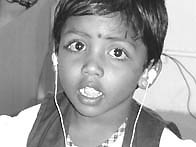 Sarva
Shiksha Abhiyan: A Mechanism to Reach Out Sarva
Shiksha Abhiyan: A Mechanism to Reach Out
The
Education Commission (1964-66), which provided for some basic
changes in the educational system at large, covered a lot
of ideas envisioned by Swami Vivekananda. The need to eradicate
illiteracy in India was very much emphasized in its report.
This was further echoed in the National Policy on Education
(1986). It is disheartening that we have not even achieved
70% literacy after fifty-seven years of independence. The
Commission wanted that all educated men and women available
be mobilized for raising a force to combat illiteracy. The
students and staff of educational institutions at all levels
should be actively involved. Every educational institution
should assume responsibility for liquidating illiteracy in
its specific area.
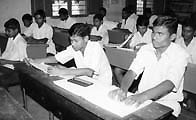 Education
for All (EFA) is still an unfinished agenda in India and this
needs to be shaped according to Swamiji’s vison. Thankfully,
the methodology adopted by the Sarva Shiksha Abhiyan (SSA)
reflects Swamiji’s ideas on mass literacy and lifelong education. Education
for All (EFA) is still an unfinished agenda in India and this
needs to be shaped according to Swamiji’s vison. Thankfully,
the methodology adopted by the Sarva Shiksha Abhiyan (SSA)
reflects Swamiji’s ideas on mass literacy and lifelong education.
SSA
- What It Is
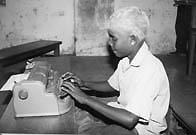 Education
is a fundamental human right of the child. Governments across
the globe are deliberating on workable policies and practices
to make education for all a reality within 2015. For its part,
the Government of India has initiated the SSA. SSA is a mission,
an effort to universalize elementary education by community
ownership of the school system. It is also an attempt to provide
an opportunity for improving human capabilities of all children.
The programme is a partnership activity between the central,
state and local governments and it also provides an opportunity
for the states to develop their own vision of elementary education. Education
is a fundamental human right of the child. Governments across
the globe are deliberating on workable policies and practices
to make education for all a reality within 2015. For its part,
the Government of India has initiated the SSA. SSA is a mission,
an effort to universalize elementary education by community
ownership of the school system. It is also an attempt to provide
an opportunity for improving human capabilities of all children.
The programme is a partnership activity between the central,
state and local governments and it also provides an opportunity
for the states to develop their own vision of elementary education.
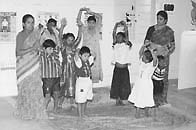 The
scheme has an excellent framework and allows a lot of flexibility
at the district level in adopting cost-effective and innovative
strategies to include all children. It covers all facets of
comprehensive education: community participation, improving
teacher skills, provision of learning materials, special emphasis
on disadvantaged groups, and so on. The
scheme has an excellent framework and allows a lot of flexibility
at the district level in adopting cost-effective and innovative
strategies to include all children. It covers all facets of
comprehensive education: community participation, improving
teacher skills, provision of learning materials, special emphasis
on disadvantaged groups, and so on.
Aims
and Objectives of SSA
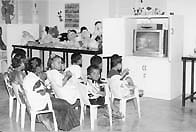 SSA’s
main aim is to provide useful and relevant elementary education
for all children in the 6-14 age group by 2010. Its another
goal is to bridge social, regional and gender gaps with the
active participation of the community in the management of
schools. Its specific objectives are the following: 1) All
eligible children must complete five years of primary schooling
by 2007, and eight years of elementary schooling by 2010;
2) Focus on satisfactory quality and education for life; 3)
Bridging all gender and social category gaps; and 4) Universal
retention by 2010. SSA’s
main aim is to provide useful and relevant elementary education
for all children in the 6-14 age group by 2010. Its another
goal is to bridge social, regional and gender gaps with the
active participation of the community in the management of
schools. Its specific objectives are the following: 1) All
eligible children must complete five years of primary schooling
by 2007, and eight years of elementary schooling by 2010;
2) Focus on satisfactory quality and education for life; 3)
Bridging all gender and social category gaps; and 4) Universal
retention by 2010.
SSA
in Coimbatore
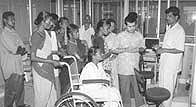 The
Coimbatore district of Tamil Nadu stands out in addressing
all facets of the programme. One especially noteworthy feature
is the district administration’s collaboration with the International
Human Resource Development Centre (IHRDC) for the disabled
of Ramakrishna Mission Vidyalaya to achieve education for
all children with disabilities much ahead of deadline. It
is a general conviction in the district that once this most
difficult group is brought under the umbrella of educational
services, the overall target could be reached effectively. The
Coimbatore district of Tamil Nadu stands out in addressing
all facets of the programme. One especially noteworthy feature
is the district administration’s collaboration with the International
Human Resource Development Centre (IHRDC) for the disabled
of Ramakrishna Mission Vidyalaya to achieve education for
all children with disabilities much ahead of deadline. It
is a general conviction in the district that once this most
difficult group is brought under the umbrella of educational
services, the overall target could be reached effectively.
Inclusive
Education: Beyond Disabilities
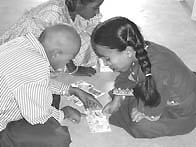 The
International Disability Alliance, a consortium of international
organizations working for persons with disabilities, has been
underlining the importance of creating a rights-based,
barrier-free, and inclusive society. The integrated
family system and community living make inclusion a natural
phenomenon in the Indian soil. The
International Disability Alliance, a consortium of international
organizations working for persons with disabilities, has been
underlining the importance of creating a rights-based,
barrier-free, and inclusive society. The integrated
family system and community living make inclusion a natural
phenomenon in the Indian soil.
Inclusion
of Persons with Unique Needs
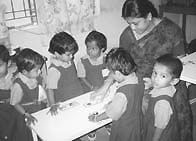 Inclusive
education has all along been an accepted approach in general
education in India, though the concept may sound recent. General
classroom teachers handle slow, average and advanced learners
- all in one class. This is ‘inclusive education’ based on
cognitive abilities though usually not labelled so. In the
case of children with visual and hearing impairments, the
main similarity between them and normal children is their
cognitive ability. This similarity supports the education
of disabled children along with normal children in the general
system. With the learning of ‘plus curriculum’ to cope with
their particular disability, these children can also compete
with normal children. Inclusive
education has all along been an accepted approach in general
education in India, though the concept may sound recent. General
classroom teachers handle slow, average and advanced learners
- all in one class. This is ‘inclusive education’ based on
cognitive abilities though usually not labelled so. In the
case of children with visual and hearing impairments, the
main similarity between them and normal children is their
cognitive ability. This similarity supports the education
of disabled children along with normal children in the general
system. With the learning of ‘plus curriculum’ to cope with
their particular disability, these children can also compete
with normal children.
Then
why is there such a big campaign that we should switch over
to inclusive education?
Special
Schools Leading to Segregation
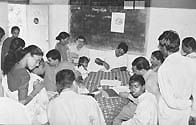 The
introduction of separate curricula changed the quality and
extent of services for disabled persons worldwide. Braille
and lip reading were miracles in the eyes of non-disabled
people, and as a result the community started treating blind
and deaf children as ‘special’. The
introduction of separate curricula changed the quality and
extent of services for disabled persons worldwide. Braille
and lip reading were miracles in the eyes of non-disabled
people, and as a result the community started treating blind
and deaf children as ‘special’.
The
growth of the special school concept and the institutionalization
of disabled children contributed to their ‘segregation’ from
society at large. Special schools became residential homes,
and the coming together of disabled persons increased their
sense of security. However, notions that disabled people are
special or that they have a sixth sense contributed to stereotyped
exclusivist responses. In special schools subjects like mathematics
and science were often neglected due to the presumption that
blind children would find them difficult. This focusing on
the ‘difference’ between disabled and normal children created
a sympathy towards the former that did not take into account
their human right to general education. As a result, education
of disabled children remained a welfare activity for decades.
 With
special schools becoming costly, inclusive education is again
gaining acceptance. In the past ‘inclusion’ was inevitable
due to lack of facilities, but today it is being seen as a
child’s human right to have education in the vicinity of his/her
home. Therefore, revitalizing the general education system
and strengthening the capacities of general classroom teachers
to train disabled children are vital concerns currently. They
have to be addressed before general education becomes truly
inclusive. With
special schools becoming costly, inclusive education is again
gaining acceptance. In the past ‘inclusion’ was inevitable
due to lack of facilities, but today it is being seen as a
child’s human right to have education in the vicinity of his/her
home. Therefore, revitalizing the general education system
and strengthening the capacities of general classroom teachers
to train disabled children are vital concerns currently. They
have to be addressed before general education becomes truly
inclusive.
Disability
Services in India: Some Models
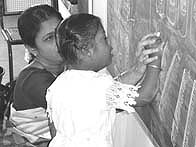 Services
for the disabled in India are more than a century old. Four
significant models are in vogue here: 1) Residential School
for the Disabled: Mostly urban, with special curriculum
including vocational training. India has nearly 3,000 such
schools serving 1.5 lakh children. 2) Integrated Education
- Resource Room Model: One specialist resource teacher
catering to 8-10 disabled children studying with and evaluated
on a par with normal children. Plus-curricular skills are
taught. This is the most prominent model in India now. 3)
Integrated Education - Itinerant Model: Specialist
itinerant teacher with resource kit visits a cluster of schools
2-3 times a week to assist the disabled. Not very popular.
4) Inclusive Education: All children with disabilities, irrespective
of severity, enrolled in general schools. All teachers oriented
to their needs. Block-level resource centre for a cluster
of schools. Currently preferred under EFA. Services
for the disabled in India are more than a century old. Four
significant models are in vogue here: 1) Residential School
for the Disabled: Mostly urban, with special curriculum
including vocational training. India has nearly 3,000 such
schools serving 1.5 lakh children. 2) Integrated Education
- Resource Room Model: One specialist resource teacher
catering to 8-10 disabled children studying with and evaluated
on a par with normal children. Plus-curricular skills are
taught. This is the most prominent model in India now. 3)
Integrated Education - Itinerant Model: Specialist
itinerant teacher with resource kit visits a cluster of schools
2-3 times a week to assist the disabled. Not very popular.
4) Inclusive Education: All children with disabilities, irrespective
of severity, enrolled in general schools. All teachers oriented
to their needs. Block-level resource centre for a cluster
of schools. Currently preferred under EFA.
Cost
considerations favour inclusion. The cost of inclusive education
per child is about Rs 1,500 to Rs 2,000 per annum as against
Rs 7,000 to Rs 20,000 in the other models.
Sound
Policy Perspectives and Practices
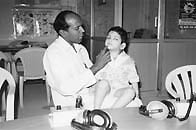 Inclusive
education revolves round three main factors - policies,
practices, and cultures. The Persons with Disabilities
Act 1995 may look trivial at first sight but it is certainly
a landmark law aiming at the inclusion of disabled persons
in the mainstream. The Rehabilitation Council of India Act
1992 is another impressive concept in maintaining quality
in special education manpower development. Many countries
have evinced interest in these landmark acts. Inclusive
education revolves round three main factors - policies,
practices, and cultures. The Persons with Disabilities
Act 1995 may look trivial at first sight but it is certainly
a landmark law aiming at the inclusion of disabled persons
in the mainstream. The Rehabilitation Council of India Act
1992 is another impressive concept in maintaining quality
in special education manpower development. Many countries
have evinced interest in these landmark acts.
In
terms of practice also, India’s achievements are remarkable.
It is true that the coverage of disabled children in its educational
programmes is not more than 10%. But a figure of roughly 2,00,000
disabled children in over 20,000 schools in India is in itself
mind-boggling. In addition, all inclusive practices are in
vogue here and we have the expertise to help other developing
nations to develop policies and practices. India’s problem
was never policies or models but expansion. Now with the SSA,
that too is being fully addressed.
Pressing
Issues for Facilitating Inclusive Education
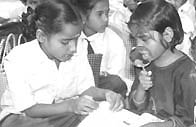 In
order to facilitate effective inclusive education, the following
three areas need utmost attention: 1) Preparing general classroom
teachers through in-service programmes, special capacity
building programmes; 2) Preparation and dissemination
of support materials by setting up context-specific resource
centres; and 3) Developing plus-curricular skills in disabled
children through deployment of special teachers, arranging
summer programmes, and teaching these skills to teachers,
peer-groups and parents. In
order to facilitate effective inclusive education, the following
three areas need utmost attention: 1) Preparing general classroom
teachers through in-service programmes, special capacity
building programmes; 2) Preparation and dissemination
of support materials by setting up context-specific resource
centres; and 3) Developing plus-curricular skills in disabled
children through deployment of special teachers, arranging
summer programmes, and teaching these skills to teachers,
peer-groups and parents.
Parameters
of Successful Inclusion
Acceptance
of inclusion by the general community, school authorities
and parents, enrolment and retention rates on a par with normal
children, admission of children irrespective of the type and
extent of disability, basic knowledge and disability-management
skills of general teachers, availability of appropriate teaching
aids, specialist teacher and peer group support, and comparable
achievements in curricular and co-curricular activities -
these constitute the parameters of successful inclusion.
Mere
creation of an environment for inclusion is not enough. Efforts
are needed to provide real educational support in the inclusive
setting. The concept of inclusion as an ideology should be
assimilated right from the classroom level, and in this context
general teachers are the key players in inclusive education.
Inclusive
Schooling for Effective Education: General Teachers Hold the
Key
Good
education realizes the fact that every child is special in
some way or other and the purpose of learning is to optimize
the child’s potential. Use of multi-sensory instruction in
the classroom makes the teacher better and at the same time
helps mentally challenged children and children with visual
and hearing impairment. So the inclusion of disabled children
depends on how effectively regular classroom teachers can
teach. That is why teachers hold the key to creating an inclusive
environment in the school.
Teachers
must recognize the fact that true learning occurs in a non-threatening
environment and try to create such an environment in the classroom.
Such an atmosphere facilitates inclusion of children who experience
learning difficulties. These children often succumb under
pressure but succeed in a non-threatening learning environment.
The
ability of the teacher to create different learning tasks
within the classroom will satisfy the educational needs of
all types of children on the basis of their cognitive and
sensory abilities and generate interest in learning.
Dr A P J Abdul Kalam often says that parents and teachers
should allow children to dream and help them realize those
dreams. In an effective inclusive setting, every child will
be able to dream his/her own vision of the future and develop
abilities to actualize it. The inclusive setting not only
increases the involvement of children, but enriches their
learning potential. It emphasizes that the child is a human
resource in the learning process.
The paradigm shift from ‘child as a student’ to ‘child as
a human resource’ paves way for a comprehensive and truly
inclusive setting, where every child is treated as special
and the teacher becomes a facilitator of learning.
Educating Children with Disabilities
through the Sarva Shiksha Abhiyan: Coimbatore Experience
In
Tamil Nadu, the SSA scheme in the case of disabled children
is being implemented through NGOs already working in the area
of disability. In Coimbatore district, Ramakrishna Mission
Vidyalaya’s IHRDC is the nodal agency for programme implementation.
All activities are initiated and monitored by an advisory
committee comprised of officials at the district level and
representatives from IHRDC.
SSA
activities include early detection and identification; functional
and formal assessment; educational placement; provision of
aids and appliances; support services; teacher training; resource
support; individualized education plan; parental training
and community mobilization; planning and management; strengthening
of special schools; and removal of architectural barriers.
Implementation
of the SSA scheme requires certain procedures to be carried
out sequentially. The district administration and the Vidyalaya
jointly conduct medical screening camps with the support
of block development officers and local officials.
The
state government allots a grant for each block for purchase
of assistive devices for disabled children and the requirements
are jointly decided by the district administration and IHRDC.
In
Tamil Nadu, more than 70,000 children with disabilities have
been identified, assessed and enrolled in schools under SSA.
In Coimbatore district 5,528 children have been identified
and assessed and 4,391 enrolled in schools. Of these, 1,137
are receiving preparatory training and 3,645 have already
benefited. The disabilities of these children range from visual
and hearing impairment to mental retardation and cerebral
palsy.
Depending
on their educational needs, the children are categorized as
follows: those with mild disabilities who can be handled by
general classroom teachers with minimum training; those with
mild/moderate disabilities who need counselling services;
those requiring occasional assistance from special educators;
and those requiring frequent assistance from special educators.
Children with moderate/severe disabilities who are in need
of resource assistance, including corrective aids and periodical
help in academic areas, are helped by the special educators
of their block.
With
the support of the district administration, block resource
centres have been established in all 22 blocks of Coimbatore
district. Their purpose is to provide necessary training,
assessment, and educational guidance to disabled children,
their parents and regular teachers. Though all disabled children
covered under the programme may not utilize the block resource
centres, those in need of continuous training and therapy
are attending these centres.
Orientation
programmes are regularly organized for block resource
supervisors, teachers, ICDS (Integrated Child Development
Services), anganwadi and health workers of the whole
district. All regular teachers working in primary and high
schools are given sensitization training on inclusion of disabled
children in regular schools by special educators and trained
block resource teachers. As the programme necessitates the
involvement of people from all sections of society, the elected
panchayat presidents are also given sensitization training
on disability management.
There
are children who need special school assistance and accommodation
for at least six moths to prepare themselves for mainstreaming
in regular schools. Suitable organizations working in the
field of disability have been selected to initiate residential
training centres to help them.
Many
village education committees (VEC) have been formed
which include selected community leaders, NGO representatives,
local headmasters and parents of children with special needs.
The objective of the VECs is to support SSA activities through
community ownership and participation.
Children
with profound mental retardation experience difficulty in
mainstreaming with the general education system. So day
care centres have been created to prepare them for a period
of one year before they are able to adapt.
Success
Stories
The
success of any programme depends on the satisfaction of its
consumers, in our case the disabled children, teachers, and
parents. The following statements provide a glimpse of the
effectiveness of the programme being implemented by Ramakrishna
Mission Vidyalaya, Coimbatore, and the district administration.
Sujitha
was suffering from locomotor disability. She was totally dependent
on others and could attend school only with the assistance
of her father. To facilitate her mobility, she was provided
with a tricycle in addition to training. Now she is attending
school like her other counterparts.
Harish
is a five-year-old. His father brought him to one of our screening
camps for inability to communicate, when he was found to have
profound hearing impairment. With hearing aids and adequate
training, Harish can now communicate significantly with his
family members and peers at the regular class.
Kalaiselvi
(13) was finding it difficult to get through in many subjects
due to poor vision. Special school teachers advised her to
continue her education in the general system. After intervention
by SSA, she was helped by her special educator to use a magnifier
for reading. She is at present attending a block resource
centre and improving her visual efficiency skills.
Nagamani’s
moderate cognitive difficulty (mental retardation) did not
allow her to perform well in class. She was always left alone
during daytime when her parents went out to work. After inclusion
in a regular school, Nagamani made many friends and started
acquiring considerable learning skills. Her parents are happy
that she is picking up some basic skills and life education
through regular and support teachers.
What
They Say
This
is what a general classroom teacher has to say: ‘Education
of disabled children is no more a problem since we have undergone
basic training under a special educator. Disabled children
pay more attention in the classroom. They never fail to approach
class teachers and peer groups whenever they are in doubt.
We are delighted to see their achievements. SSA is helping
them gain confidence.’
The
peer group has a tremendous impact on the personality
development of disabled children. Some normal children describe
how the SSA transformed their attitudes towards disability
issues: ‘Initially we did not know how to help or communicate
with our disabled friends. The training given by special teachers
has been very useful to us in establishing a good rapport
with them. Inclusion of a disabled boy or girl in our class
is not at all a problem for us. It is our responsibility to
help them. We usually help our disabled friends in their academic
studies during intervals, lunch time or after class hours.
It helps us to recapitulate what we learnt in the classroom
and also strengthens our friendship.’
That
parents also are key players in the SSA programme needs
no special mention. Their encouraging words go a long way
in reinforcing our confidence: ‘The special educator appointed
under SSA helped a great deal in enabling my son to pick up
necessary basic skills and get enrolled in a regular school.
Though he is visually impaired, he is able to manage his day-to-day
activities, including his education.’ ‘Before inclusion my
daughter, who is mentally retarded, could not do anything
independently. She was restless and friendless. Now she has
developed a good behaviour and can perform simple tasks by
herself.’ The parents are happy that their children are getting
education in local schools along with their peers.
The
heads of educational institutions are the main catalysts
in the whole experiment. Their statements reflect their support
for the programme: ‘The training given by special educators
to regular teachers is very helpful in educating disabled
children in mainstream schools. We know a child who has speech
problems but has learnt communication skills after inclusion.
As a matter of fact, disabled children are performing very
well in academic studies. Also they have more friends than
normal children. Moreover, wheelchairs provided through SSA
allow disabled children easy access to school.’
Recognition
In
2003-04 the Tamil Nadu government recognized the contribution
of Ramakrishna Mission Vidyalaya, Coimbatore, by selecting
it as the best nodal agency implementing the SSA programme
for disabled children. The recognition has only increased
the centre’s responsibility to perform even better and bring
every disabled child in its purview under the umbrella of
education.
Conclusion
A
rose is still a rose when it loses a petal. A tree may lose
some leaves, but it is still useful. Likewise, a human being
can still be useful despite the loss of a physical faculty.
Helen Keller says that the most unfortunate person in society
is one who has sight but no vision. In order to understand
the abilities of persons with disabilities, one needs to have
a broad vision of humanistic values. An inclusive society
needs the support of parents, teachers, professionals and
other community members. The SSA is determined to create such
an inclusive society in India. Though the performance of states
vary, the climate in general is conducive to the extension
of educational services to disabled children. By bringing
these children into the mainstream, we will in fact be empowering
them with their rights.
|


